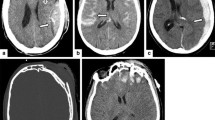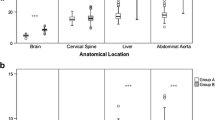Abstract
To evaluate the impact of a picture archiving and communication systems (PACS)–based software package on the requests for 3D reconstructions of multidetector CT (MDCT) data sets in the emergency radiology of a level 1 trauma center, we reviewed the number and type of physician requests for 3D reconstructions of MDCT data sets for patients admitted after sustaining multiple trauma, during a 12-month period (January 2003–December 2003). During the first 5 months of the study, 3D reconstructions were performed in dedicated workstations located separately from the emergency radiology CT interpretation area. During the last 7 months of the study, reconstructions were performed online by the attending radiologist or resident on duty, using a software package directly incorporated into the PACS workstations. The mean monthly number of 3D reconstructions requested during the two time periods was compared using Student’s t test. The monthly mean ± SD of 3D reconstructions performed before and after 3D software incorporation into the PACS was 34±7 (95% CI, 10–58) and 132±31 (95% CI, 111–153), respectively. This difference was statistically significant (p<0.0001). In the multiple trauma patient, implementation of PACS-integrated software increases utilization of 3D reconstructions of MDCT data sets.
Similar content being viewed by others
References
Wintermark M, Mouhsine E, Theumann N et al (2003) Thoracolumbar spine fractures in patients who have sustained severe trauma: depiction with multi-detector row CT. Radiology 227:681–689
Sheridan R, Peralta R, Rhea J, Ptak T, Novelline R (2003) Reformatted visceral protocol helical computed tomographic scanning allows conventional radiographs of the thoracic and lumbar spine to be eliminated in the evaluation of blunt trauma patients. J Trauma 55:665–669
Hauser CJ, Visvikis G, Hinrichs C, Eber CD et al (2003) Prospective validation of computed tomographic screening of the thoracolumbar spine in trauma. J Trauma 55:234–235
Berne JD, Velmahos GC, El-Tawil Q et al (2000) Value of complete cervical helical computed tomographic scanning in identifying cervical spine injury in the unevaluable blunt trauma patient with multiple injuries: a prospective study. J Trauma 47:896–902
Borrelli J Jr, Goldfarb C, Catalano L, Evanoff BA (2002) Assessment of articular fragment displacement in acetabular fractures: a comparison of computerized tomography and plain radiographs. J Orthop Trauma 16:449–456
Kickuth R, Laufer U, Hartung G, Gruening C, Stueckle C, Kirchner J (2002) 3D CT versus axial helical CT versus conventional tomography in the classification of acetabular fractures: a ROC analysis. Clin Radiol 57:140–145
Haveri M, Junila J, Suramo I, Lahde S (1988) Multiplanar and 3D CT of acetabular fractures. Acta Radiol 39:257–264
Potok PS, Hopper KD, Umlauf MJ (1995) Fractures of the acetabulum: imaging, classification, and understanding. RadioGraphics 15:7–23
Buitrago-Tellez CH, Schilli W, Bohnert M, Alt K, Kimmig M (2002) A comprehensive classification of craniofacial fractures: postmortem and clinical studies with two- and three-dimensional computed tomography. Injury 33:651–668
Liow RY, Birdsall PD, Mucci B, Greiss ME (1999) Spiral computed tomography with two- and three-dimensional reconstruction in the management of tibial plateau fractures. Orthopedics 22:929–932
Jurik AG, Albrechtsen J (1994) The use of computed tomography with two- and three-dimensional reconstructions in the diagnosis of three- and four-part fractures of the proximal humerus. Clin Radiol 49:800–804
Pretorius ES, Fishman EK (1999) Volume-rendered three-dimensional spiral CT: musculoskeletal applications. RadioGraphics 19:1143–1160
Soto JA, Munera F, Morales C et al (2001) Focal arterial injuries of the proximal extremities: helical CT arteriography as the initial method of diagnosis. Radiology 218:188–194
Munera F, Soto JA, Palacio DM et al (2002) Penetrating neck injuries: helical CT angiography for initial evaluation. Radiology 224:366–372
Gavant ML, Flick P, Menke P, Gold RE (1996) CT aortography of thoracic aortic rupture. AJR 166:955–961
Parker MS, Matheson TL, Rao AV et al (2001) Making the transition: the role of helical CT in the evaluation of potentially acute thoracic aortic injuries. AJR 176:1267–1272
Killeen KL, Mirvis SE, Shanmuganathan K (1999) Helical CT of diaphragmatic rupture caused by blunt trauma. AJR 173:1611–1616
Michel LA, Lacrosse M, Decanniere L, Rosiere A, Vandenbossche P, Trigaux JP (1997) Spiral computed tomography with three-dimensional reconstructions for severe blunt abdominal traumas: a useful complementary tool? Eur J Emerg Med 4:87–93
Author information
Authors and Affiliations
Corresponding author
Rights and permissions
About this article
Cite this article
Soto, J.A., Lucey, B.C., Stuhlfaut, J.W. et al. Use of 3D imaging in CT of the acute trauma patient: impact of a PACS-based software package. Emerg Radiol 11, 173–176 (2005). https://doi.org/10.1007/s10140-004-0384-x
Received:
Accepted:
Published:
Issue Date:
DOI: https://doi.org/10.1007/s10140-004-0384-x




